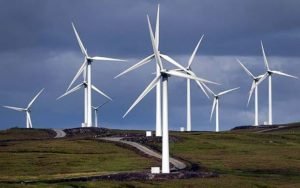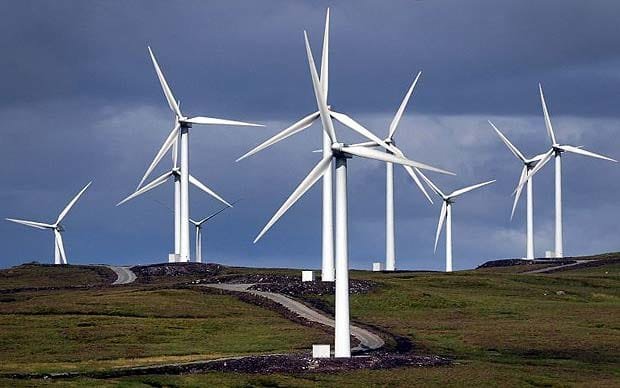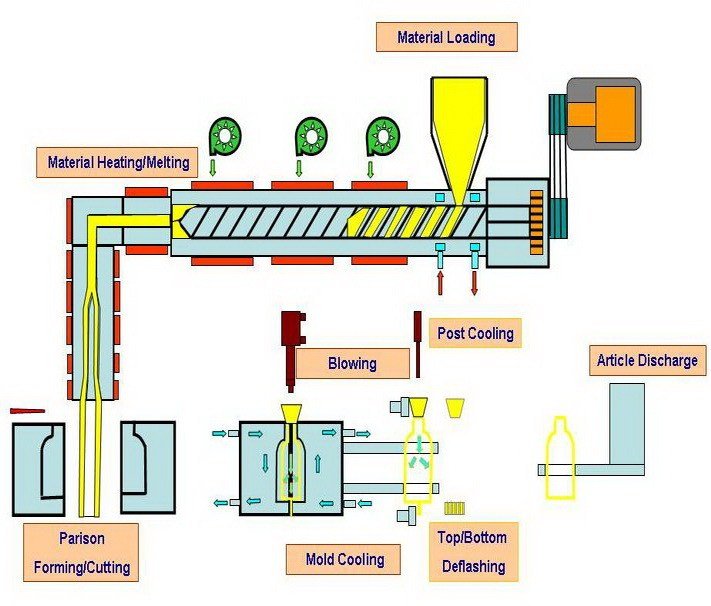HOW COMPOSITE MATERIALS ARE USED IN WIND ENERGY TECHNOLOGY
Brief:
The reduction of fossil fuel dependency is an important goal for both developed anddeveloping countries of the world. To achieve this goal, the renewable energy production, in particular, wind energy generation, must be drastically increased. This can be realized by installation and expansion of many off-shore and on-shore wind
parks built with large and extra-large wind turbines. Due to the high costs of repair and maintenance of extra-large, off-shore or remotely located wind turbines, the reliability of wind turbines, first of all, its most important part, rotor, should be increased to ensure efficient work for 20 and more years. The durability and high lifetime of wind turbine can be ensured, among others, if the wind blade materials have very high stiffness, strength, fatigue damage and environmental loading resistances as well as low weight. For this, the advanced composites should be developed, improved and utilized in wind turbines.

Introduction:
The first wind turbine for electric power generation was built by the company S.Morgan-Smith at Grandpa’s Knob in Vermont, USA, in 1941. The turbine (53.3 m rotor, 2 blades, power rating 1.25 MW) was equipped with massive steel blades. One of the blades failed after only a few hundred hours of intermittent operation. Thus, the importance of the proper choice of materials and inherent limitations of metals as a wind blade material was demonstrated just at the beginning of the history of wind energy development.
The next, quite successful example of wind turbine for energy generation is so called Gedser wind turbine, built by Johannes Juul for the electricity company SEAS at Gedser coast in 1956-57. The turbine was produced already with composite blades, built from steel spars, with aluminium shells supported by wooden ribs. The turbine (three blades, 24 m rotor, 200 kW) war the first success story of wind energy: it has run for 11 years without maintenance. After 1970s,
most of wind turbines were produced with composite blades (Manwell et al, 2002, Brøndsted et al, 2005). Thus the development and use of composite materials for turbine parts became evident from the first steps of wind energy utilization: while the first turbine, built with steel blades, failed, the second one, with composite blades, worked for many years.
Composites are materials, which consist of two or more chemically dissimilar constituents with different properties. Thanks to their superior mechanical properties, higher strength and lower weight, as compared to many metals and alloys, as well as the possibility of tailoring the microstructures, composites found a broad applications in structural, civil and mechanical engineering, automotive industry as well as energy applications.
- Why do composite materials play the key role in the wind energy development?
The goal of fossil fuel independency in nearest decades means that the renewable energy sector has to be drastically expanded. EU set a target to receive 20% of its energy needs from renewables by 2020. In order to supply 20% of electricity from renewable sources to 2020, the EU off-shore wind energy capacity should be expanded by two orders of magnitude. The high volumes of wind energy generation, necessary to achieve this goal, require the installation and use of very large wind turbines (8-10MW and higher) standing in wind farms of several hundred MW. In this case, the potential costs of repair and replacement of damaged wind turbines might be huge. Generally, a wind turbine should work for 20-25 years without repair and with minimum maintenance. The work of wind turbine in this case means (among other factors) that the blade deformation should be very small (to sustain the aerodynamic properties of the blade and avoid hitting the tower), that the fatigue effects (due to gravitation forces at rotation and cyclic loading by wind) are negligible and that the blades can also sustain extreme wind loads. The problem of ensuring high reliability of wind turbines becomes especially important for large and extra-large turbines, because of high wind and gravitational loads, on the one side, and the difficulties of repair of large turbines, on the other side.
In view of these requirements, only materials with the very high strength, fatigue resistance and stiffness – i.e., composites, – can be used in wind turbine blades. No other materials, – neither metals, nor alloys, nor wood, – can satisfy this list of requirements fully. Henceforth composite materials been playing big role in wind energy technology applications.
- Wind Turbine Rotor Blades: Construction, Loads and Requirements
Among all the parts of wind turbines (blades, hub, gearbox, generator, nacelle, tower…), composite materials are used in blades and nacelles. The main requirements to nacelles, which provide weather protection for the components, are the low weight, strength and corrosion resistance. Typically, nacelles are made from glass fiber composites.
Blades represent the most important composite based part of a wind turbine, whose properties quite often determine the performances and lifetime of the turbine.
Still, the failure rates of wind turbine blades are of the order of 20% within three years (Richardson, 2010), and this is surely too much. Increasing the reliability and lifetime of wind blades is an important problem for the developers of wind turbines.
The wind turbine blades are built as follows.
A blade consists of two faces (on the suction side and the pressure side), joined together and stiffened either by one or several integral (shear) webs linking the upper and lower parts of the blade shell or by a box beam (box spar with shell fairings). The box beam inside the blade is adhesively joined to the shell.
Wind turbine blades are subject to the external loading, which includes the flap wise and edgewise bending loads, gravitational loads, inertia forces, loads due to pitch acceleration, as well as torsional loading. The flap wise load is caused mainly by the wind pressure, while the edgewise load is caused both by gravitational forces and torque
load. The biggest edgewise bending moment is at the blade root. The flap wise and edgewise bending loads cause high longitudinal, tensile and compressive stresses in the material. The upwind side of the blades is subject to tensile stresses, while the downwind side is subject to compression. The flap wise and edgewise bending moments lead to the fatigue damage growth.
The wind blades are also subject to cyclic loadings, caused by wind variations, turbulences, wind shear, and other effects, like pressure variations of air around the tower.
During the functioning, the stability of the blade shape (aerodynamic profile), high durability and reliability should be ensured. The shape stability corresponds to the minimum deflection of the blade under wind loads. This is achieved by increasing the moment of inertia of the blade (using the corresponding blade design) and by increasing the flexural stiffness of the wind blade material. The flap wise bending is resisted by the spar, internal webs or spar cabs inside the blade, while the edges of the profile carry the edgewise bending. Table 1 summarizes the roles of the parts of wind blades in maintaining the blade shapes.
The wind blades are produced with multiaxial fabrics. Often, +/-45º laminates are used in the blade skin and in the shear web. In the root area, triaxial materials are utilized, +/- 45º/90º. Spar caps are produced from unidirectional composites, with some biaxial plies. In unsupported parts of the wind shell, the sandwich composites are used. They ensure the shape stability of blade shell. The core of the sandwich bears the shear load, while the composite skin resists the bending stresses. The sandwich structures ensure much higher stiffness than the monolithic composites. The sandwich core materials, placed between two composite plies, are typically polymer foams, balsa wood or in some cases honeycomb types.
Table: Wind blade parts and their functions in maintaining the blade shapes
| Part | Function | Materials used |
| Blade shell | Maintaining the blade shape, resisting the wind and gravitational forces |
Strong, lightweight composites |
| Unsupported parts of the shell |
Resisting the buckling load |
Thickened sandwich structures with light core materials and multidirectional face laminates |
| Integral web, spars or box beam |
Resisting the shell buckling/ shear stresses due to flap wise bending |
Biaxial lay-ups at +/-45o, |
| Adhesive layers between composite plies, and the web and the blade shell |
Ensuring the out of plane strength and stiffness of the blade |
Strong and highly adhesive matrix |

The main requirements to wind turbine blades can be summarized as follows:
- High strength (to withstand even extreme winds, as well as gravity load),
• High fatigue resistance and reliability (to ensure the stable functioning for more than 20 years and 108 cycles),
• Low weight (to reduce the load on the tower, and the effect of gravitational forces),
• High stiffness (to ensure the stability of the aerodynamically optimal shape and orientation of the blade during the work time, as well as clearance between blade and the tower).
- Composites for Wind Turbine Blades: Main Constituents and Manufacturing
In order to ensure the required shape stability, strength and damage resistance of the wind turbine rotor blades, the blades are produced from long fiber reinforced polymer laminates. In these composites, long fibers ensure longitudinal stiffness and strength, while the resin matrix is responsible for fracture toughness, delamination strength and out-of-plane strength and stiffness of the composite.
3.1. Fibers
The stiffness of composites is determined by the stiffness of fibers and their volume content. Most often, E-glass (i.e., borosilicate glass called “electric glass” or “E-glass” for its high electric resistance) fibers are used as main reinforcement in the composites. The main properties of E-glass fibers are as follows:
Young modulus E 70…77 GPa, density 2.55…2.64 kg/m3, diameter 8…15 µm, failure strain 4.5…4.9%. With increasing the volume content of fibers in UD composites, the stiffness, tensile and compression strength increase proportionally, yet, at high volume content of fibers (after 65%), there might be dry areas without resin between fibers and the fatigue strength of the composite reduces. Typically, the glass/epoxy composites for wind blades contain up to 75 weight % glass.
Many investigations toward the development of fibers, which are stronger than the usual E-glass fibers, have been carried out. The high strength fibers (which are still used seldom in practice, but represent a promising source of the composite materials improvement) include glass fibers with modified compositions (S-glass, R-glass, etc.), carbon fibers, basalt and aramid fibers.
S-glass (i.e. high strength glass, S means “Strength” here) developed in the 1960s for military applications, has 40% higher tensile and flexural strengths, and 10…20% higher compressive strength and flexural modulus, than the E-glass. The main properties of Sglass are: Young modulus E 86-90 GPa, density 2.46…2.49 kg/m3, failure strain 5.4…5.8%. Still, the S-glass is much more expensive than E-glass.
S2 glass was developed in the 1968 by Owens Corning company as a commercial, non-military version of S-glass. S glass and S2 glass fibers have the same composition (magnesium alumino-silicate). The main differences are in sizing and certification procedure. The price of S2-glass is around 10 times of that of E-glass.
R-Glass fibers, introduced by Vetrotex in 1968, are produced with a calcium aluminosilicate glass with less silica and added oxides. The main properties of R-glass are: Young modulus E 84-86 GPa, density 2.55 kg/m3, failure strain 4.8 %. Some other special glasses developed by Owens Corning are ECRGLAS (in 1980) and Advantex (in 1997).
Relatively recently, in 2006, Owens Corning company developed WindStrandTM glass fibers, which have 15 percent higher stiffness and up to 30 percent higher strength when compared to traditional glass fiber reinforcements, and show very good fatigue properties under both tension and compression loading.
Carbon fibers attracted large interest of industry and research community as a very promising alternative to the glass fibers. Carbon fibers have much higher stiffness and lower density than the glass fibers (Young modulus E = 220-240 GPa, density 1.7-1.8 kg/m3; failure strain 0.7%), thus, allowing the thinner blade profile as well as stiffer and lighter blades. However, they have relatively low damage tolerance, compressive strength and ultimate strain, and are much more expensive than the E glass fibers (7…20 times.
Furthermore, carbon fiber reinforced composites are very sensitive to the fiber misalignment and waviness: even small misalignments lead to the strong reduction of compressive and fatigue strength. In some cases, the problem of efficient wetting carbon fibers in vacuum infusion has been observed, thus, leading to the use of more expensive prepreg technology for the producing carbon fiber based composites.
The carbon fibers are used mainly by the wind turbine makers Vestas and Gamesa in structural spar caps of large blades. Another possibility is to use carbon layers locally in the root end of wind blades, with some kind of transition from carbon to the glass reinforcements in other parts of the blade, while carbon fibers provide the highest stiffness among all the fibers, high strength glasses provide the best combination of stiffness, strength and impact resistance. Further alternative options of non-glass, high strength fibers include aramid and basalt fibers.
Aramid (aromatic polyamide) fibers have high mechanical strength, and are tough and damage tolerant. However, the compressive strength of aramid fibers is even lower than that of carbon. Their mechanical properties are as follows: Young modulus E 133…135 GPa, density 1.44 kg/m3, failure strain 2.5…4 %. Aramid fibers were introduced by the company DuPont as Kevlar. However, aramid fibers absorb moisture, can degrade
under the influence of ultraviolet radiation and have relatively low adhesion to polymer resins.
Basalt fibers, with their good mechanical properties, represent also an interesting alternative to the glass fibers. Basalt fibers are 30% stronger, 15…20% stiffer and 8…10% lighter than E-glass, and cheaper than the carbon fibers.
3.2 Matrix
Due to the low weight requirement to the wind blades, polymers are the main choice as the matrix material for the wind blade composites. As noted above, matrix of composite controls fracture toughness, delamination strength and out-of-plane strength and stiffness of the composite, and influences the fatigue life of the composites.
Typically, thermosets (epoxies, polyesters, vinyl esthers) or (more seldom) thermoplastics are used as matrixes in wind blade composites.
Thermosets based composites represent around 80% of the market of reinforced polymers. The advantages of thermosets are the possibility of room or low temperature cure, and lower viscosity (thus, allowing better impregnation and adhesion). Initially, polyester resins were used for composite blades. With the development of large and extra-large wind turbines, epoxy resins replaced polyester and are now used most often as matrixes of wind blade composites.
While polyester is less expensive and easier to process (needs no post-curing), epoxy systems are stronger (high tensile and flexural strength) and more durable as compared with polyester resins. Epoxy matrixes ensure better fatigue properties of the composites. The production of epoxy based composites is more environmentally friendly. Still, recent studies (e.g., by Swiss company DSM Composite Resins) support arguments for the return to unsaturated polyester resins, among them, faster cycle time and improved energy efficiency in the production, stating that the newly developed polyesters meet all the strength and durability requirements for large wind blades.
Thermoplastics represent an interesting alternative to the thermoset matrixes. The important advantage of thermoplastic composites is their recyclability. Their disadvantages are the necessity of high processing temperatures (causing the increased energy consumption and possibly influencing fiber properties) and, difficulties to manufacture large (over 2 m) and thick (over 5 mm) parts, due to the much higher viscosity. The melt viscosity of thermoplastic matrices is of the order 102-103 Pax s, while that for thermosetting matrix is around 0.1-10 Pax s. Thermoplastics (as differed from thermosets) have melting temperatures lower than their decomposition temperatures, and, thus, can be reshaped upon melting. While the fracture toughness of thermoplastics is higher than that of thermosets, fatigue behaviour of thermoplastics is generally not as good as thermosets, both with carbon or glass fibers.
Other advantages of thermoplastics include the larger elongation at fracture, possibility of automatic processing, and unlimited shell life of raw materials.
Further, the development of matrix materials which cure faster and at lower temperatures is an important research area. Resins with faster cure and lower curing temperature allow reducing the processing time and automating the manufacturing. In some cases, thixotropic agents, like fumed silica and certain clays, are used to control viscosities of resins during manufacturing.
In several works, the possibilities of improvement of composites properties by adding nano-reinforcement in matrix were demonstrated. Additions of small amount (at the level of 0.5 weight %) of nano-reinforcement (carbon nanotubes or nanoclay) in the polymer matrix of composites, fiber sizing or interlaminar layers can allow to increase the fatigue resistance, shear or compressive strength as well as fracture toughness of the composites by 30…80%. Graphite particles fiber coatings on glass fibers allow increasing the fatigue life up to 100 times.
Summarizing the brief overview, one can state that apart from the basic solution (epoxy/E-glass composites) widely used for medium and large wind blades, there are several very promising directions of development of stronger, more reliable and economically producible composites, among them:
- High strength fibers (strong glasses, carbon, aramid, other fibers) can ensure higher stiffness and sometimes better strength and damage resistance of composites; the disadvantages are higher costs and in some cases lower compressive strength (carbon fibers) and high sensitivity to local defects (e.g., misalignment). Hybrid composites with mixed E-glass and high strength fibers allow to achieve the combination of higher stiffness (due to carbon fibers) with limited cost increase
- Thermoplastic resin matrixes, as opposed to the widely used epoxy matrix, are recyclable, can be reshaped upon melting and have higher fracture strain. Their disadvantages are high processing temperatures and higher viscosity, leading to the more expensive and difficult processing times. Resins with faster cure and lower curing temperature allow us to reduce the processing time and automate the manufacturing. Further, the nanomodified matrixes or sizing on fibers have a potential to increase the fatigue strength of the composites.




